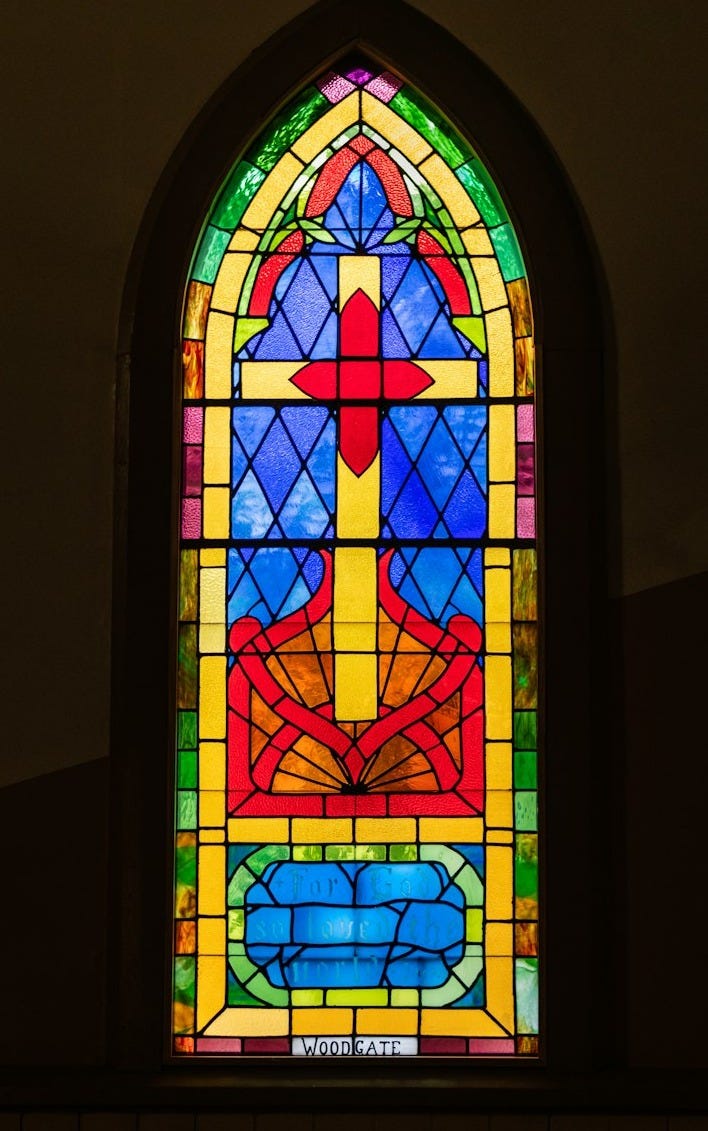
STAINED GLASS WINDOW 2013 Cross with Lilies I want to say that it is like a sword of light sliding straight and strong from a flowered sheath, or that it is like some bright angular seed pod rising from the blossoms that bore it and ready to sow new life on the earth — but really it is like nothing except itself: that shape, even refined in glowing ruby glass, is its own and no other, a shape of execution. How have we grown used to it? How do we dare to sculpt its edges and frame it with lilies, then glance around for some more stirring picture? When did Love’s murder turn to a cliché? Rinsed in the spring-gold radiance that surrounds it, do we no longer notice the blood-bright stain at the center? Forgiveness is true, beauty and the blossom of new life are real, and in their midst — a sword that reaps, a seed that sows again — this other thing, this wound through which the light pours jewel-red, blood-red, this shape we give to Love in killing it, a shape grown too familiar to catch our eyes. We look away, forgiven, moving on.
STAINED GLASS WINDOW 2016
The Crucified Christ
What happened here
is finished.
What remains
is stripped and still.
Sky above, earth below,
are stripped and still,
and so is the wood of the tree
that has taught its shape
to the lean broken body.
Bleeding, agony,
abandonment, are finished.
The worst has happened.
The worst is done.
This is the moment of quiet
before the next thing happens
except that sky, earth, tree,
and the lean broken body
do not know there is a next thing.
What happened to them here
is finished. They are not waiting.
They are stripped. They are still.During a lifetime’s journey through several Christian denominations, I have listened to a lot of sermons about the cross. I’ve preached some. The story of Jesus’s death on the cross, and of what happened next, is as central to my faith as it is to the faith of most Christians.
The story of the cross means as much to me as it ever did; more, the longer I live and pray. The symbol of the cross? The one at the top of the church spire, behind the altar, hanging from a pretty chain around someone’s neck, tastefully depicted in stained glass? That, I’ve realized recently, I can do without. The longer I’ve lived with the story of the cross, the more the symbol of the cross has become, for me, a symbol of Empire, specifically of Empire’s default response to being confronted with embodied Divine Love — swift, brutal, entirely legal execution. No thank you, I won’t be wearing that as jewelry.
There the cross is, though, at the center of the story around which I’ve chosen to shape my life. I understand the story of the cross, and of what happened next, as a story about Divine Love’s response when Empire seeks to kill and bury it: a story of the ultimate, most fruitful act of nonviolent resistance, the ultimate truth of what happens when a grain of wheat falls to the earth and dies. Empire is quick to identify and co-opt powerful symbols for its own purposes. Meanwhile Love keeps showing up in the streets to heal and feed and dance and teach and suffer and die, and then shows up again (and again, and again) to find us where we’re hiding, dazed with grief and fear, and tell us that the story isn’t over, that it’s time to get up and do some more dancing.




I would love to hear you give a sermon one day. Thank you for these meditations on the cross, Elizabeth.
Beautiful poetry, as always, and thank you for seeing this truth. "I understand the story of the cross, and of what happened next, as a story about Divine Love’s response when Empire seeks to kill and bury it: a story of the ultimate, most fruitful act of nonviolent resistance..."
I'm grateful for this perspective and call to action, Elizabeth. The story isn't over. I want to believe it can never be, so long as there are those who'll dance.